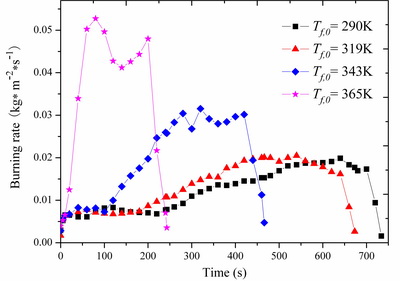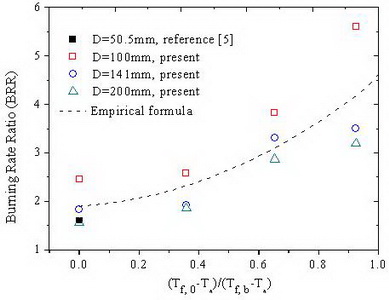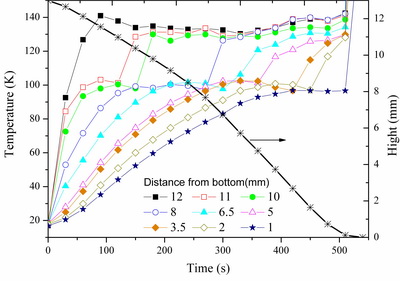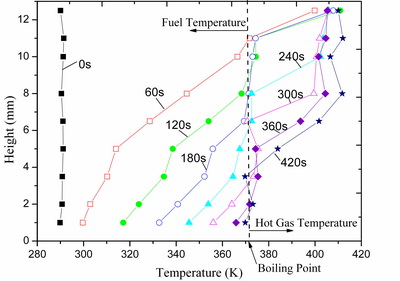Fire development is generally characterized by burning rate vs. time. Furthermore, the burning rate, determines the heat release rate history of the fire growth. Generally, hazard assessments of liquid pool fires require characterization of the fire growth rate history and the peak burning rate. Thus, determining the burning rate is an essential aspect of a fire hazard analysis.
The burning rate is not a natural property of a fuel and, therefore, cannot be calculated directly from the basic material properties. It is usually determined from fire tests. Previous work showed that the burning rate of fuels varies with the pool diameter before reaching their asymptotic value when the diameter reaches a critical value, typically of the order of 1-2m in terms of the pool diameter for most common fuels.
Burning behaviors of thin-layer pool fire at which the fuel surface decreases in the vertical direction as it burns has been explored. The work is motivated both by the desire to understand fundamental phenomena of pool fires at different initial fuel temperatures and the attempts to explain the mechanisms of heat transfer between the fuel and the surrounding environment. The work has been published in high-quality journals, such as “Chinese Science Bulletin” (2010), “Journal of Hazardous Materials” (2011), and “Journal of Fire Science” (2011), etc. The reviewers gave good comments and said that “It is the most comprehensive study of the effect of temperature on pool fire burning rates and the burning rate process to date, which, despite the large literature on pool fires, has been studied only in passing until now.”
Burning rate of pool fire under various fuel temperatures was investigated. Figure 1 shows the burning rate history and relation of the burning rate ratio (BRR) and dimensionless initial fuel temperature. The burning rate exhibited five typical stages: initial development, steady burning, transition, bulk boiling burning, and decay. The burning rate during the steady burning stage was observed to be relatively independent of the initial fuel temperature. In contrast, the burning rate of the bulk boiling burning stage increases with increased initial fuel temperature. BRR shows the difference of the burning rate between the steady burning stage and bulk boiling burning stage. BRR tends to become larger as the initial fuel temperature increases, because of the increasing of burning rate in the bulk boiling burning stage.
 |  |
Figure 1. Burning rate history of heptane pool fire and the burning rate ratio |
In order to understand the heat transfer mechanisms, temperature distributions in the liquid and environment were measured. Figure 2 showed that the fuel surface temperature increased to its boiling point, with the temperature of fuel below the surface starting to rise shortly after ignition. A boiling zone was formed that increased with time. A theoretical analysis based on a heat-transfer model is proposed to explain the differences in heat transfer between the liquid and environment during the different burning phases. The results showed that when the fuel is boiling, evaporation is enhanced due to the increases of the heat transfer from the flame and wall to the fuel but also from a decreasing conductive heat loss in the depth of the fuel bed and also an increase of absorbed heat at the fuel surface as a result of an increase of fuel surface area from the bubble.
 |  |
Figure 2. Temperature profiles at different heights and fuel height varies with time |